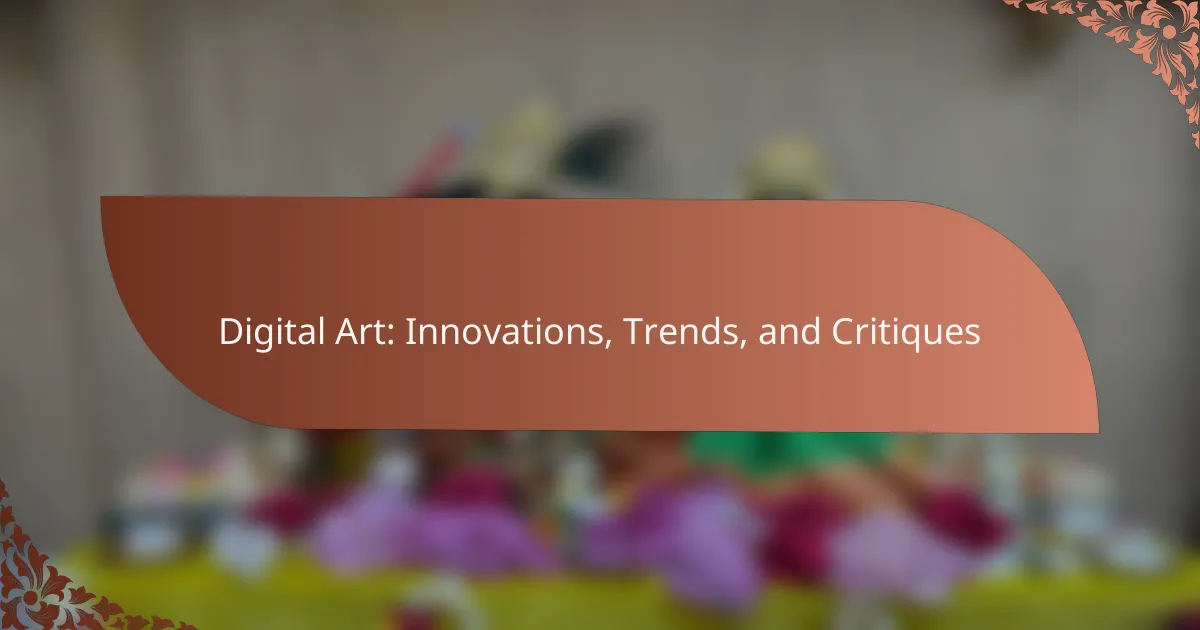Digital art is transforming how we create and experience art through innovations like AI-generated pieces and blockchain technology. Key trends include generative art and NFT integration, which offer new monetization avenues. Cultural influences shape diverse expressions, while critiques focus on authenticity and accessibility challenges. The future promises immersive technologies and decentralized platforms, enhancing engagement and equity in the digital art landscape.
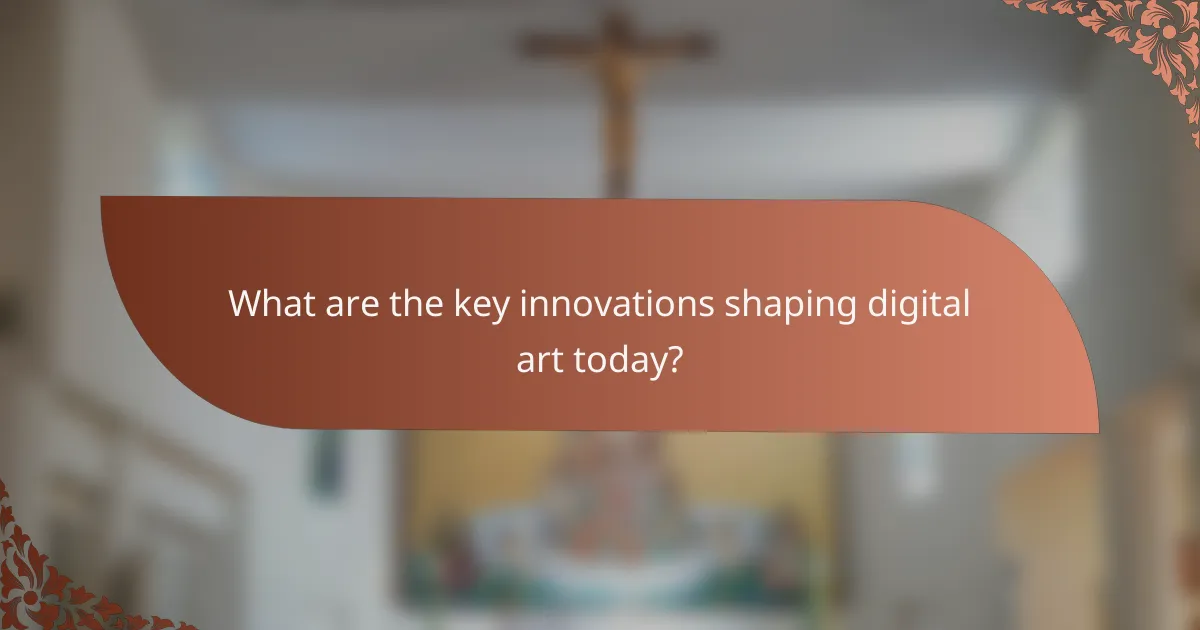
What are the key innovations shaping digital art today?
Key innovations shaping digital art today include AI-generated art, augmented reality experiences, and blockchain technology for ownership verification. These advancements enhance creativity and redefine art consumption. AI tools enable artists to explore new styles and techniques, while augmented reality immerses audiences in interactive experiences. Blockchain ensures authenticity and provenance, allowing artists to monetize their work effectively.
How has technology influenced the creation of digital art?
Technology has significantly transformed digital art creation by enhancing tools and accessibility. Innovations such as software advancements, high-resolution displays, and digital drawing tablets have expanded artistic possibilities. Artists can now experiment with various styles and techniques that were previously unattainable. Additionally, platforms for sharing and selling digital art have democratized access, allowing artists to reach global audiences. As a result, digital art continues to evolve, reflecting contemporary trends and critiques in the art world.
Which software and tools are essential for digital artists?
Essential software and tools for digital artists include graphic design software, drawing tablets, and 3D modeling tools. These tools enhance creativity and streamline the artistic process.
Key software includes Adobe Photoshop for raster graphics, Adobe Illustrator for vector graphics, and Corel Painter for a traditional painting experience. Drawing tablets like Wacom provide precision and control. 3D modeling tools such as Blender and Autodesk Maya enable artists to create immersive environments.
Emerging tools like Procreate and Clip Studio Paint are gaining popularity for their user-friendly interfaces and robust features. These innovations support various artistic styles and techniques.
Investing in high-quality software and tools significantly impacts the quality and efficiency of digital art creation.
What role do online platforms play in the distribution of digital art?
Online platforms significantly enhance the distribution of digital art by providing accessible marketplaces and community engagement. These platforms enable artists to showcase their work globally, reaching wider audiences without traditional gallery constraints. They also facilitate direct sales, allowing artists to retain a larger share of profits. Furthermore, social media channels contribute to the promotion and sharing of digital art, fostering connections between creators and collectors. Overall, online platforms democratize access to art and empower artists to thrive in a competitive landscape.
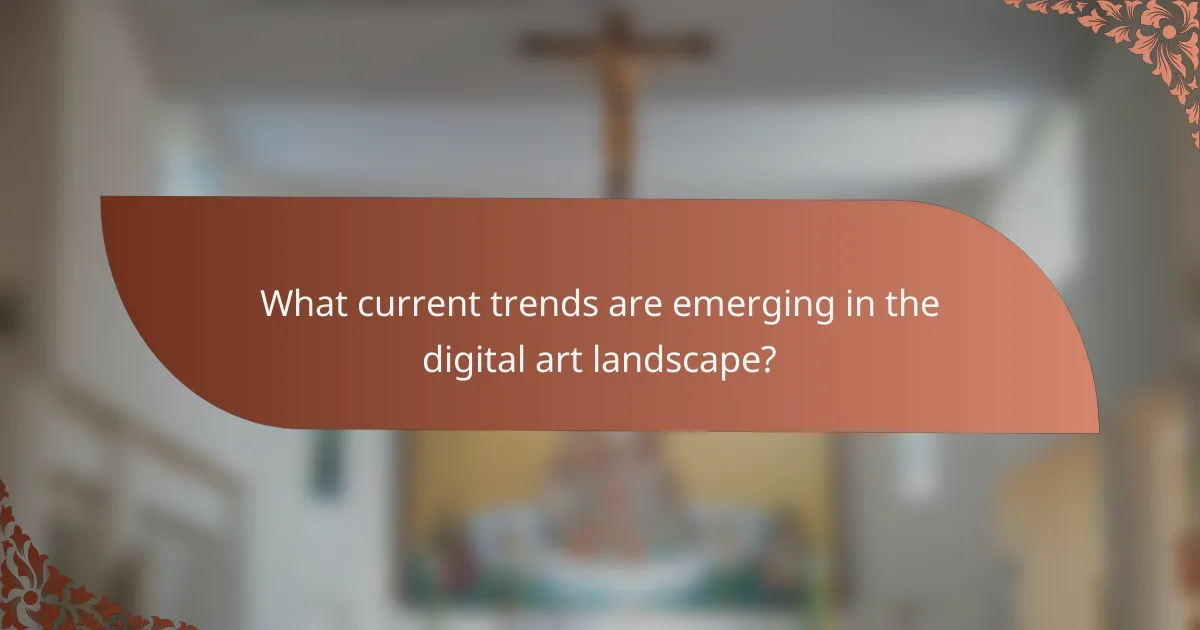
What current trends are emerging in the digital art landscape?
Emerging trends in the digital art landscape include the rise of generative art, NFT integration, and immersive experiences. Generative art utilizes algorithms to create unique pieces, enhancing creativity. NFTs offer new monetization avenues, allowing artists to sell digital ownership. Immersive experiences, like virtual reality galleries, engage audiences in innovative ways. These trends reflect a shift towards technology-driven creativity, appealing to both artists and collectors.
How is AI transforming the creation and perception of digital art?
AI is revolutionizing digital art by enhancing creativity, automating processes, and reshaping audience engagement. Artists leverage AI tools to generate unique styles and compositions, allowing for unprecedented experimentation. This innovation fosters collaboration between human creativity and machine intelligence, resulting in diverse artistic expressions. As a result, the perception of digital art evolves, with audiences increasingly valuing AI-generated works alongside traditional methods. This transformation highlights a unique attribute of digital art: its adaptability and integration of technology.
What are the implications of NFTs for digital artists?
NFTs significantly empower digital artists by providing new revenue streams and enhancing ownership rights. They allow artists to sell unique, verifiable digital assets directly to collectors, bypassing traditional gatekeepers. This shift fosters a more equitable art market. Additionally, NFTs can include royalties for future sales, ensuring ongoing income for creators. The rise of NFTs also encourages collaboration and innovation within the digital art community, as artists explore new formats and concepts. However, environmental concerns related to blockchain technology and market volatility present challenges that artists must navigate.
Which styles and genres are gaining popularity in digital art?
Digital art styles and genres gaining popularity include 3D art, augmented reality (AR) art, and generative art. These forms reflect technological advancements and evolving aesthetic preferences.
3D art has surged due to enhanced software and hardware capabilities, allowing artists to create immersive experiences. Augmented reality art engages viewers interactively, bridging the gap between digital and physical spaces. Generative art, driven by algorithms, offers unique creations that challenge traditional artistic boundaries.
As a result, these styles exemplify the dynamic nature of digital art, appealing to diverse audiences and fostering innovation.
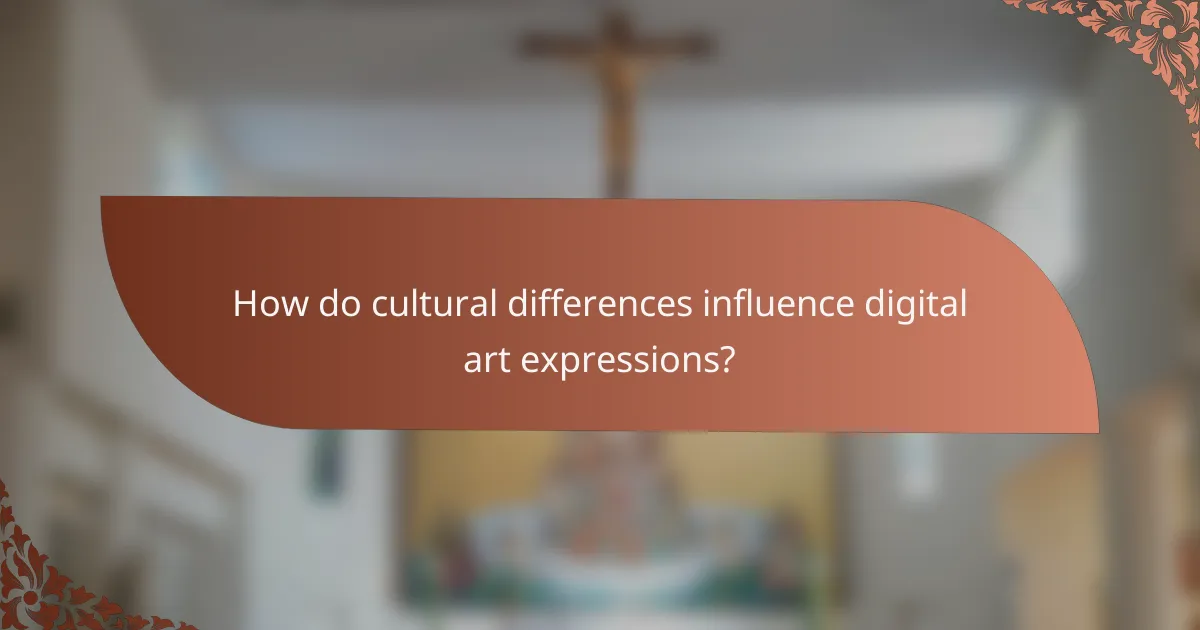
How do cultural differences influence digital art expressions?
Cultural differences significantly shape digital art expressions by influencing themes, styles, and techniques. Artists draw on their cultural backgrounds, leading to diverse representations and interpretations. For example, Eastern art often emphasizes harmony and nature, while Western art may focus on individualism and abstraction.
These variations result in unique attributes, such as color symbolism and narrative structures, which reflect cultural values. Additionally, globalization has led to a blending of styles, creating hybrid forms that challenge traditional boundaries. As a result, digital art becomes a platform for cultural dialogue, fostering understanding and appreciation across communities.
What unique characteristics define digital art communities in different regions?
Digital art communities exhibit unique characteristics influenced by regional culture, technology access, and artistic trends. For instance, North America emphasizes innovation and commercial viability, while European communities often focus on traditional techniques blended with modern digital practices. In Asia, rapid technological advancement fosters a vibrant scene that embraces both local and global influences. African digital art communities highlight storytelling and cultural heritage, creating a distinct narrative style. Each region’s unique attributes shape its digital art landscape, reflecting diverse artistic expressions and collaborative opportunities.
How do audiences perceive digital art across cultures?
Audiences perceive digital art differently across cultures, influenced by local aesthetics and technological access. Cultural backgrounds shape interpretations and appreciation levels. For instance, Western audiences often focus on innovation and technique, while Eastern audiences may emphasize harmony and traditional themes. Additionally, socio-economic factors can affect exposure to digital art, impacting overall perceptions. The rise of global platforms allows for cross-cultural exchanges, enriching the understanding of digital art worldwide.
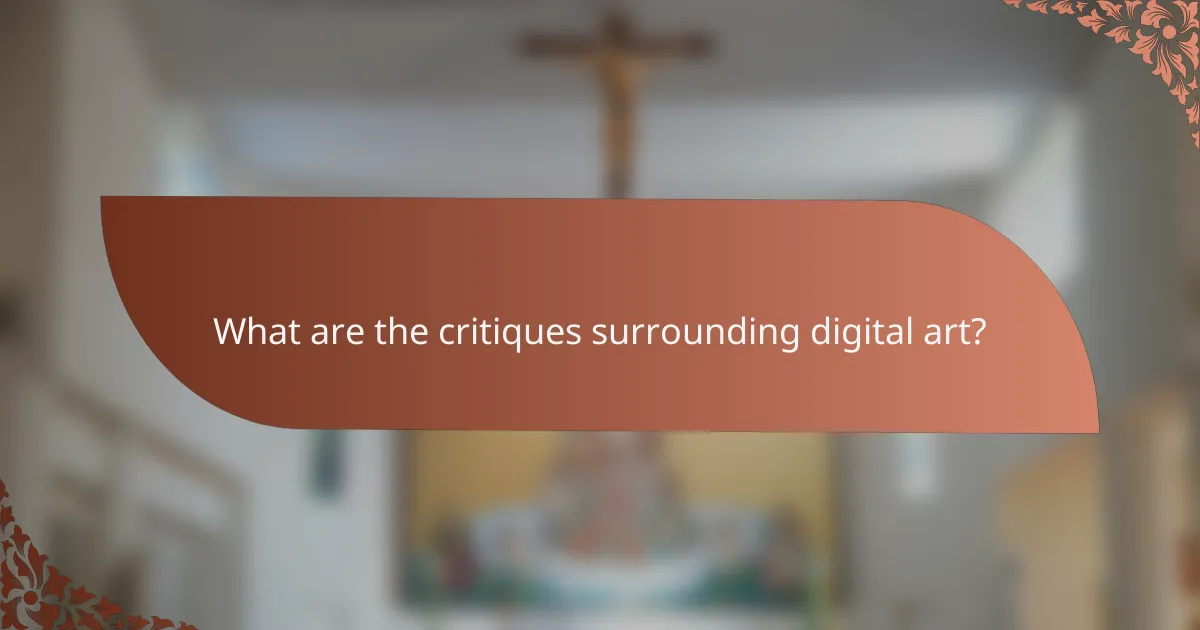
What are the critiques surrounding digital art?
Digital art faces critiques regarding authenticity, value, and accessibility. Critics argue that digital creations lack the tangible quality of traditional art forms. Additionally, the ease of reproduction raises questions about originality and ownership. Some believe that the proliferation of digital platforms dilutes artistic merit. Furthermore, access to technology can create disparities among artists, impacting diversity in the digital art landscape.
What are the main arguments against the legitimacy of digital art?
Digital art faces skepticism regarding its legitimacy primarily due to concerns about originality, value, and artistic merit. Critics argue that digital art lacks the tactile qualities of traditional mediums, making it feel less authentic. The ease of replication raises questions about originality, as digital files can be duplicated effortlessly. Additionally, the market for digital art, including NFTs, is often viewed as speculative, leading to doubts about long-term value. Some traditional artists dismiss digital works as less legitimate, arguing that the skill required is diminished by accessible software tools.
How do digital art critics evaluate the quality and impact of artworks?
Digital art critics evaluate artworks by analyzing aesthetic quality, originality, and cultural impact. They assess technical execution, emotional resonance, and the artist’s intent. Critics also consider audience engagement and the work’s relevance within contemporary digital trends. Factors like innovation and the use of technology play significant roles in their evaluations.
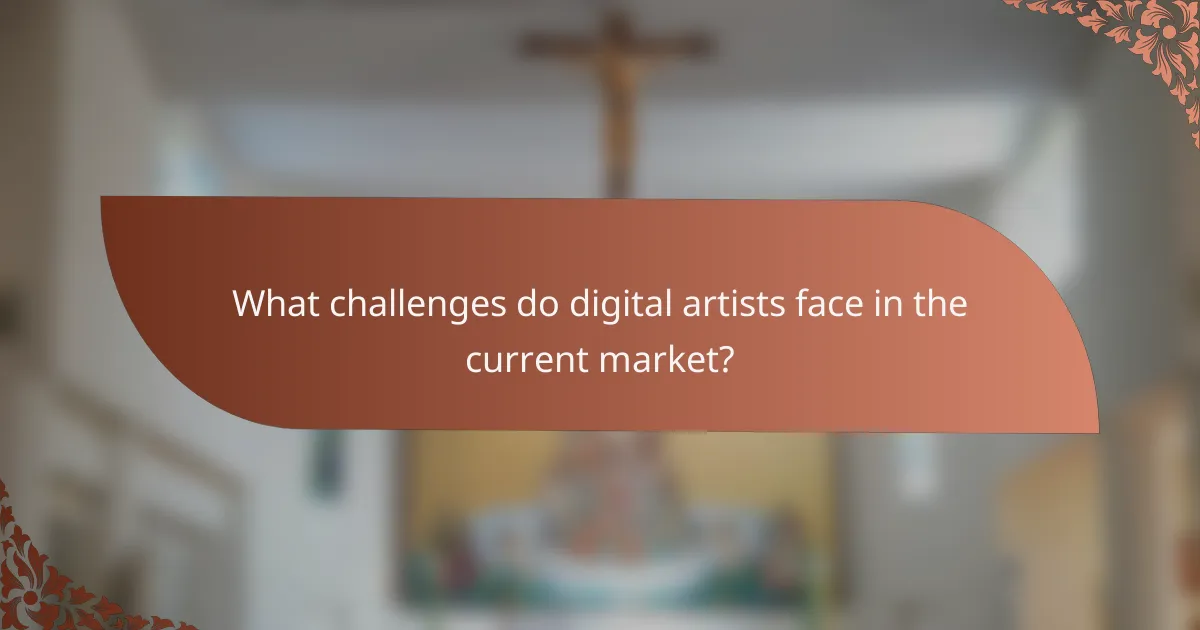
What challenges do digital artists face in the current market?
Digital artists face significant challenges in the current market, including competition, pricing pressures, and evolving technology. The saturation of the digital art space makes it difficult for artists to stand out. Many struggle with pricing their work fairly while attracting clients. Additionally, rapid advancements in technology require constant adaptation, which can be overwhelming. These factors contribute to a complex landscape for digital artists aiming to succeed.
How do copyright issues affect digital art creators?
Copyright issues significantly impact digital art creators by restricting their control over their work. Many artists face challenges in protecting their creations from unauthorized use or reproduction. Copyright infringement can result in financial loss and diminished recognition. Additionally, the rise of digital platforms complicates enforcement, as artworks can be easily shared and copied. Understanding copyright laws is essential for artists to safeguard their rights and navigate the digital landscape effectively.
What is the impact of market saturation on emerging digital artists?
Market saturation negatively impacts emerging digital artists by increasing competition and reducing visibility. As more artists enter the market, it becomes challenging for newcomers to stand out. This saturation often leads to lower prices for artwork, limiting potential earnings. Additionally, established artists may dominate platforms, making it harder for new talent to gain exposure. Emerging artists must innovate and leverage unique styles or niches to navigate this crowded landscape effectively.

What future developments can we anticipate in digital art?
Future developments in digital art will focus on immersive technologies, AI integration, and decentralized platforms. Artists will increasingly leverage virtual reality and augmented reality to create engaging experiences. Artificial intelligence will enhance creativity, offering tools for generative art and personalized content. Additionally, blockchain technology will empower artists through secure ownership and new monetization models, fostering a more equitable art ecosystem.
How might advancements in technology further alter digital art creation?
Advancements in technology will significantly enhance digital art creation by introducing new tools and techniques. Emerging technologies like artificial intelligence and augmented reality enable artists to explore innovative forms of expression. AI algorithms can assist in generating unique designs, while augmented reality allows for immersive experiences that blend digital and physical art. Additionally, advancements in hardware, such as more powerful graphic tablets, improve precision and responsiveness in the creative process. These innovations not only expand artistic possibilities but also democratize art creation, making it accessible to a broader audience.
What trends should digital artists be aware of to stay relevant?
Digital artists should focus on emerging technologies, community engagement, and sustainability trends to remain relevant. The integration of artificial intelligence in art creation is transforming workflows and expanding creative possibilities. Additionally, artists are increasingly collaborating with brands and other creators, enhancing visibility and market reach. Sustainability in materials and practices is becoming essential, appealing to environmentally conscious consumers. Staying updated on social media trends and platforms is crucial for audience engagement and showcasing work effectively.
What best practices can digital artists adopt for success in 2025?
Digital artists can achieve success in 2025 by embracing emerging technologies, engaging with communities, and continuously evolving their skills. Adopting AI tools can enhance creativity and efficiency. Collaborating with other artists fosters innovation and expands networks. Staying updated on market trends ensures relevance and adaptability. Regularly showcasing work on various platforms increases visibility and potential opportunities.
